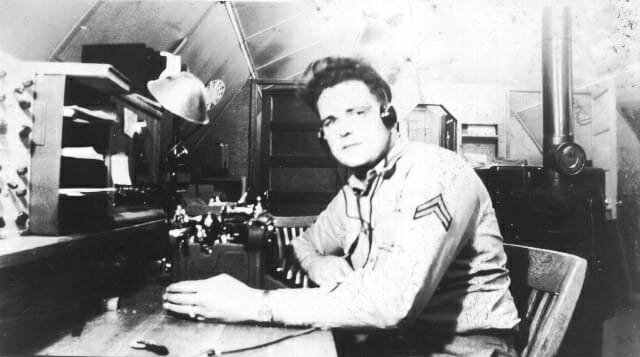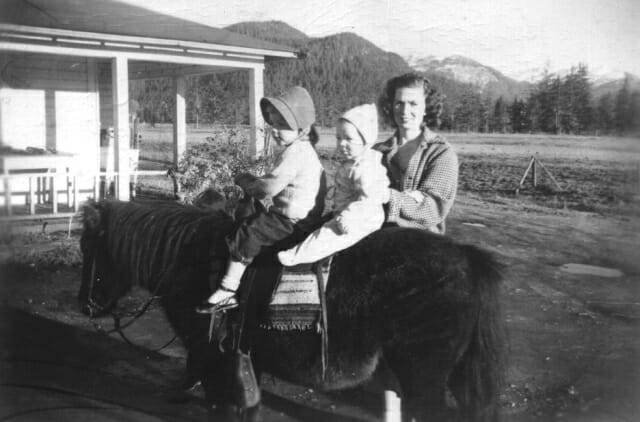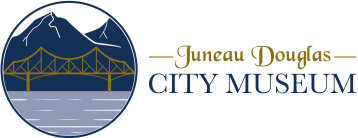Gastineau Channel Memories
Ward, Maynard P.
Maynard P. Ward
In March 1942, fresh from short-wave radio training, a few Alaska Communication System Army buddies and I, traveling by steamship, arrived in Juneau, our first station. We were excited to put into practice the Morse code we had been perfecting for the past three months. Having grown up in Kansas, I could only stare, as in a trance, at the sight of Juneau clinging to the foot of that tall, tall mountain. Juneau people were hometown, warm and friendly. Without means of transportation, any free time was spent exploring the streets and hiking the trails above town. Our stay was short. I hoped some day to return. The next two years were spent on the Alaska Peninsula, then Fairbanks until the end of World War II and my discharge. Alaska and radio communications had grown on me. Within a year, I reenlisted.
After stations in Wrangell and Flat, then back to Seattle for transmitter maintenance training, to my happy surprise once again I was assigned to Juneau, arriving in February 1949. That spring our family ? my wife, Mary, and three kids, Ron, Nancy and John - watched from Douglas as the melting snow cascaded down the mountain with a crashing thud filling Thane Road (an accident prone road that time of year) before tumbling over into Gastineau Channel.
Without a car, it was necessary from Douglas to ride the bus to and from work. I soon found a house for us on the hillside above South Franklin Street. Traversing the hillside stairs was a great way to keep in shape. Carrying groceries was another matter. We had a monthly account with a downtown grocery that delivered. The panoramic view was a plus. The port and Gastineau Channel was an ever-changing scene with steamers, fishing boats and floatplanes.
My work was a pleasure. We not only sent and received telegrams via teletype, we monitored radio emergency frequency 500. It was not unusual to receive calls for help. Sometimes ships were in distress, or someone aboard was ill or injured. Throughout the day, we had radio schedules for weather reports to ships at sea. At those times all the radio ?chit chat? stopped. After the weather report, we called each ship on our list. If there was no response, an alert was sent out. Messages were relayed.
Mary found it a bit unsettling on the hillside that summer to experience one of Alaska?s earth tremors. Even more unsettling was the heavy rain. As the hillside became saturated, mud, rocks and trees came sliding down. One large tree became embedded in the house next door. Amazingly, neither the couple nor their parrot was hurt. Another tree slid between the two houses. It was enough to cause an order for all ACS personnel to move from the hillside. We were fortunate to move into one half of a remodeled barracks, at the transmitter sight at 11 mile Glacier Highway. A new home with a basement had been built for personnel. The basement served all of us for drying laundry and a warm place for the kids to ride their trikes. We also shared baby sitting, so parents could occasionally spend an evening in town.
We had saved enough money to start buying a Nash car. At last we could do some sightseeing. A little further out the gravel road at Auke Bay, DeHarts? was our quick stop store. Any time of year the Skater?s Cabin at Mendenhall was a favorite picnic spot. Knowing Mary?s love of fish, one day I returned from town with a large
ice block of frozen smelt. Mary was more dismayed than delighted. I saved the day by inviting friends for a smelt fry at Skater?s Cabin.
Another day as we started to town, we discovered a flaw with the Nash?s rear doors. They opened the wrong way. Three and a half year old Ron, attempting to open the window, opened the door. Caught by the breeze, the door flew open flinging him out. Luckily he was wearing a leather cap with earflaps and a heavy coat with a fur collar. The doctor found nothing broken, just a few gravel scratches on his face.
A young minister, trying to establish regular community church services, invited all the neighborhood families to the Chapel by the Lake. To reach the Chapel, it was necessary to maneuver a slippery bank. The kids thought it was great fun.
The Kendlers? Dairy was nearby. They delivered milk, cream and eggs to our group of families. Cows, and some times a bull, grazed in the pasture bordering the transmitter site. Bear and deer were often seen among them. At Christmas, Mr. Kendler made his deliveries with a horse drawn sleigh and jingling bells. With the coming of spring, a favorite Sunday afternoon pastime was visiting the Kendler farm to let the kids ride the Shetland pony. The scene across the road was an artist?s delight. With Mendenhall Glacier in the background, a fox family romped in the meadow of flowers in the foreground.
Property near Auke Bay was available for homesteading but without funds to make improvements, for us it was just a dream. When the time came to reenlist, I declined. Until 1967, we made our home in the ?lower 48.? With our kids through high school, the time seemed right to return to Juneau, this time, as a civilian with ACS. That is another story about deep snow, Taku winds and bears on the porch. Our four children (Barbara joined the family in 1950) spent some time employed in Juneau too. Ron came with his family in 1970. It has been his home every since. He has Color Vue TV and Appliance. To care for an elderly parent, Mary and I departed Juneau on the Wickersham ferry in 1972. We returned to Alaska in the summer of 1978 to work for ACS in Nome until September 1982, when I retired back to Oregon.
 |
Maynard P. Ward radio operator, 1949, Juneau transmitter station. |
 |
Nancy, John and Mary Ward, Kendler Farm, 1949. |
